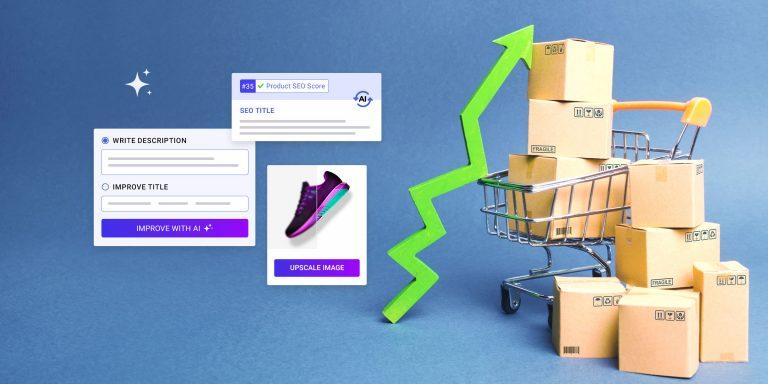Promising low startup costs, minimal inventory requirements, and the ability to run your business from anywhere. It’s no wonder so many people are eager to jump into dropshipping. But with all the hype comes a burning question: Can dropshipping really make you rich?
The short answer? Yes, dropshipping has the potential to be quite profitable. But the longer, more nuanced answer requires an exploration of what it truly takes to succeed in this competitive space and why it may not be as easy or glamorous as some say. Let’s start by exploring a bit why dropshipping is such an attractive business model.
Table of Contents
Why is the dropshipping dream so attractive?
The idea of building a profitable ecommerce business without holding inventory or managing complex logistics is, quite frankly, a dream come true. Essentially, you list products in your store, sell them to customers, and your supplier handles the packaging and shipping. This means you don’t need a warehouse, and your overhead costs remain relatively low. Here are some key reasons people want to start dropshipping:
- Low startup costs: You don’t need to invest in bulk inventory upfront, which means you can start with a small budget compared to traditional retail businesses.
- Flexibility: Dropshipping allows you to run your store from anywhere. All you need is a laptop and internet connection.
- Diverse product range: Since you aren’t storing products, you can offer a wide variety of items in your store without worrying about inventory.
- Automation potential: With tools and platforms available to automate much of the work, dropshipping can be streamlined for efficiency, leaving you more time to focus on growth and marketing.
With all these amazing benefits, it’s easy to understand why so many people are drawn to dropshipping as a way to achieve financial freedom. But as with any business, there are challenges.
The reality: Can you get rich quickly?
Here’s the thing: dropshipping success is possible, but it’s not a get-rich-quick scheme. Actually this is one of the reasons over 90% of dropshipers fail. The notion that you can sit back and watch the money roll in while doing minimal work is a myth. In fact, most successful dropshippers will tell you that making a substantial income from this business requires hard work, strategic thinking, and dedication.
Let’s break down what you need to understand:
1. It takes time to build
In dropshipping, success doesn’t happen overnight. Many dropshipping “gurus” might show you flashy revenue screenshots, but what they don’t reveal is the months (or even years) it took to build that business. From finding winning products to perfecting your store’s user experience, building a dropshipping business requires time, patience, and persistence.
Additionally, paid advertising plays a huge role in driving traffic and sales, but learning how to master Facebook Ads, Google Ads, or TikTok Ads takes time. Expect to invest in testing and refining your ad strategy before you start seeing significant returns.
Read more: How to Launch a Dropshipping Business in 6 Easy Steps
2. Profit margins are slim
While dropshipping eliminates the need for upfront inventory, one of its biggest drawbacks is slim profit margins. Since you rely on suppliers to handle fulfillment, you typically pay more for each product compared to those buying in bulk. Additionally, competitive pricing in the ecommerce world means you need to keep your prices attractive to customers, further squeezing your margins.
To truly make dropshipping profitable, you need to sell products at a higher scale, which can be challenging without a solid marketing strategy. It’s not uncommon for dropshippers to work with thin profit margins (e.g., 10-30%) on each sale. However, scaling your business and keeping customers coming back can improve profitability in the long run.
Read more: The True Cost of Dropshipping – What Nobody Tells You
3. You’re competing in a crowded market
One of the major challenges in dropshipping is the sheer level of competition. With barriers to entry so low, many newcomers are flooding the market, often selling the same products sourced from similar suppliers. To stand out, you need to think beyond just selling trending products and focus on building a strong brand.
Consider this: customers aren’t just looking for products; they’re looking for experiences. Successful dropshipping businesses differentiate themselves by creating a unique brand identity, based on inspiring storytelling, offering exceptional customer service, and providing value that goes beyond the transaction. This could mean creating engaging content, offering bundled deals, or focusing on niche products that have a dedicated customer base.

The keys to dropshipping success
Now that we’ve covered some of the realities, let’s look at what it takes to succeed (and potentially get rich) in dropshipping.
1. Product research is key
Not all products are created equal, and finding the right product to sell is often the difference between success and failure in dropshipping. Rather than relying on guesswork, you should use data to guide your product selection. Look for products with consistent demand, low competition, and good profit margins.
You also want to avoid jumping on trends too late. If you notice that hundreds of stores are already selling a particular product, it might be time to pivot and look for the next big thing. Tools like Google Trends, Facebook Audience Insights, and Amazon Best Sellers can help you spot opportunities before they become oversaturated.
Read more: 10 Best Trending Products To Dropship In 2024
2. Branding is essential
As mentioned earlier, competition in dropshipping is fierce, which means your brand needs to shine. Customers are becoming more savvy and can easily spot a generic dropshipping store. To stand out, you need to create a dropshipping brand that speaks to your target audience.
So, invest time in developing a professional, trustworthy, immersive website. From the logo to the product descriptions to the overall user experience, every detail counts. Having a strong brand builds trust with customers, which leads to higher conversion rates and, ultimately, repeat purchases.
3. Mastering marketing
Marketing is the engine that drives dropshipping success. Paid advertising on platforms like Facebook, Instagram, Google (specifically Google Shopping Ads), and TikTok can bring in a steady stream of traffic, but it takes time and skill to get it right. You’ll need to experiment with different ad creatives, target audiences, and messaging to find what works for your store.
As we always recommend here, use Facebook, Instagram or TikTok for low-ticket items that are also visually appealing and Google Shopping Ads for high-ticket products.
In addition to paid ads, you should also focus on organic marketing strategies like SEO (search engine optimization) and content marketing. Building a social media presence, starting a blog, or creating YouTube videos can help you generate free traffic over time, reducing your reliance on paid ads.
4. Customer retention and upselling
Customer acquisition costs can be high in dropshipping, so it’s essential to focus on customer retention and maximizing the lifetime value of each buyer. Upselling and cross-selling strategies can help increase the average order value, while email marketing campaigns can bring customers back for repeat purchases.
Offering personalized experiences, special discounts, or loyalty programs are great ways to keep your customers engaged and coming back for more. Remember, repeat customers are often the most profitable.
Read more: How to Build and Maintain Customer Trust in Your Dropshipping Business
So, can dropshipping make you rich?
Well, yes, dropshipping can make you rich, but it requires more than just setting up a store and waiting for sales. Successful dropshippers put in the effort to master product research, branding, marketing, and customer retention. They invest time in learning and adapting to changes in the ecommerce landscape.
With the right approach, dropshipping has the potential to become a profitable and scalable business. However, it’s not an easy or guaranteed path to wealth. As with any business, success comes down to how much work you put in, how many test strategies you test, or if you can evolve with the market.
So, the potential is there, but it’s up to you to make it happen.
Read next: How to Make Your First $1K in Dropshipping











